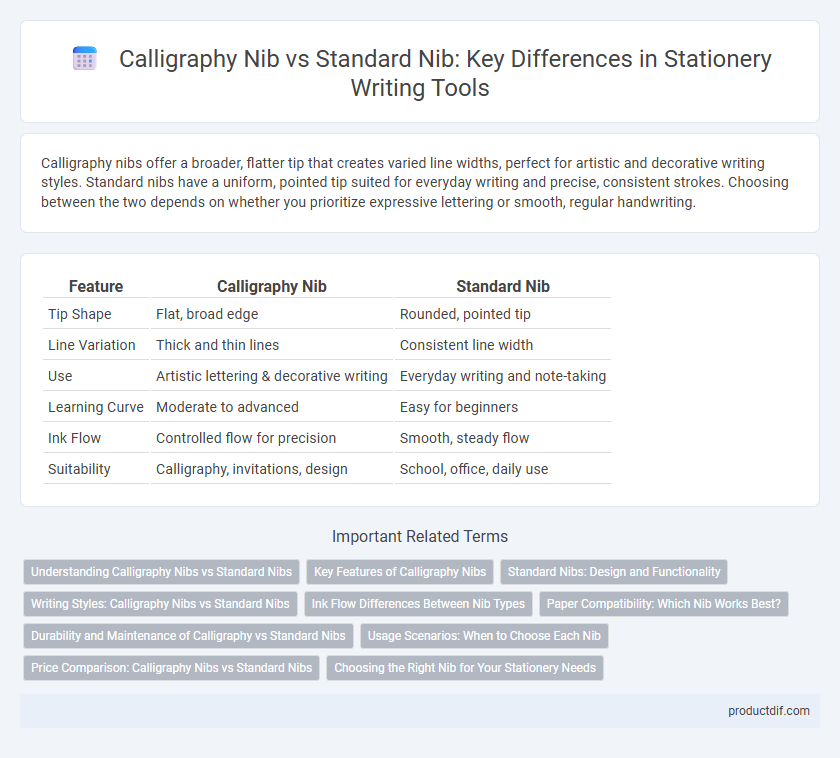Calligraphy nibs offer a broader, flatter tip that creates varied line widths, perfect for artistic and decorative writing styles. Standard nibs have a uniform, pointed tip suited for everyday writing and precise, consistent strokes. Choosing between the two depends on whether you prioritize expressive lettering or smooth, regular handwriting.
Table of Comparison
| Feature | Calligraphy Nib | Standard Nib |
|---|---|---|
| Tip Shape | Flat, broad edge | Rounded, pointed tip |
| Line Variation | Thick and thin lines | Consistent line width |
| Use | Artistic lettering & decorative writing | Everyday writing and note-taking |
| Learning Curve | Moderate to advanced | Easy for beginners |
| Ink Flow | Controlled flow for precision | Smooth, steady flow |
| Suitability | Calligraphy, invitations, design | School, office, daily use |
Understanding Calligraphy Nibs vs Standard Nibs
Calligraphy nibs feature broader, flatter tips designed to create varying line widths essential for decorative writing styles, while standard nibs have pointed tips suited for consistent, smooth lines ideal for everyday writing. The shape and flexibility of calligraphy nibs enable expressive strokes that shape characters with artistic flair, contrasting with the uniform ink flow of standard nibs that prioritize legibility. Understanding these differences helps users select the appropriate nib for tasks ranging from formal invitations to daily note-taking.
Key Features of Calligraphy Nibs
Calligraphy nibs feature broader, flat tips that create thick and thin strokes essential for artistic letterforms, unlike standard nibs that produce uniform lines. These nibs vary in size and shape to support diverse calligraphy styles such as Italic, Gothic, and Copperplate, enhancing line contrast and elegance. Their flexible metal construction allows for controlled ink flow, delivering precise, expressive writing ideal for decorative and formal documents.
Standard Nibs: Design and Functionality
Standard nibs are engineered for everyday writing, featuring a uniform tip that provides consistent ink flow and smooth line quality. Their durable design supports various writing styles, making them ideal for quick notes, journaling, and professional documents. Compared to calligraphy nibs, standard nibs prioritize versatility and ease of use, ensuring reliable performance across different paper types.
Writing Styles: Calligraphy Nibs vs Standard Nibs
Calligraphy nibs feature a flat, broad tip designed to create varying line widths, making them ideal for decorative writing and artistic flourishes. Standard nibs typically have a rounded, pointed tip that produces consistent, uniform strokes suited for everyday handwriting and note-taking. The choice between calligraphy and standard nibs significantly influences the overall writing style, with calligraphy nibs emphasizing expressive elegance and standard nibs prioritizing practicality and legibility.
Ink Flow Differences Between Nib Types
Calligraphy nibs feature flexible, split tips that allow variable line widths and controlled ink flow, producing elegant strokes essential for artistic writing. Standard nibs maintain a consistent ink flow designed for uniform lines, facilitating smooth and steady writing without variation in thickness. The difference in ink flow between calligraphy and standard nibs directly impacts the style and precision of handwriting, making nib choice critical for specific writing techniques.
Paper Compatibility: Which Nib Works Best?
Calligraphy nibs perform best on smooth, high-quality paper designed to absorb ink evenly, preventing feathering and ensuring sharp, precise lines. Standard nibs are more versatile, compatible with a broader range of papers including everyday copy and notebook paper, though they may produce less defined strokes on textured surfaces. For optimal results in detailed writing and artistic projects, pairing calligraphy nibs with premium, acid-free paper enhances ink flow and longevity.
Durability and Maintenance of Calligraphy vs Standard Nibs
Calligraphy nibs typically feature a broader, flat tip designed for decorative writing, which may require more frequent cleaning and careful handling to maintain sharp edges, impacting their overall durability compared to standard nibs. Standard nibs, often made from stainless steel or gold alloys, provide greater resilience for everyday use and demand less meticulous maintenance. Choosing calligraphy nibs involves balancing the artistic quality with their sensitivity to corrosion and wear, whereas standard nibs excel in longevity and ease of upkeep.
Usage Scenarios: When to Choose Each Nib
Calligraphy nibs are ideal for artistic writing, decorative lettering, and creating varied line widths in invitations or greeting cards. Standard nibs excel in everyday writing tasks, note-taking, and professional documents where uniform strokes and accuracy are essential. Selecting a nib depends on whether the priority is expressive, stylized script or consistent, legible handwriting.
Price Comparison: Calligraphy Nibs vs Standard Nibs
Calligraphy nibs typically cost more than standard nibs due to their specialized design and craftsmanship required for artistic writing styles. Standard nibs are generally more affordable, catering to everyday writing needs without the intricate shaping found in calligraphy nibs. Price ranges for calligraphy nibs usually start around $5 to $20, whereas standard nibs can be found for as low as $1 to $5.
Choosing the Right Nib for Your Stationery Needs
Calligraphy nibs offer flexible tips designed for creating varied line widths and ornate lettering, making them ideal for artistic and decorative writing tasks. Standard nibs provide consistent, uniform lines suited for everyday writing, note-taking, and general correspondence. Selecting the right nib depends on your stationery needs, such as whether you prioritize elegant, stylized fonts or reliable, smooth writing performance for daily use.
Calligraphy nib vs Standard nib Infographic

 productdif.com
productdif.com